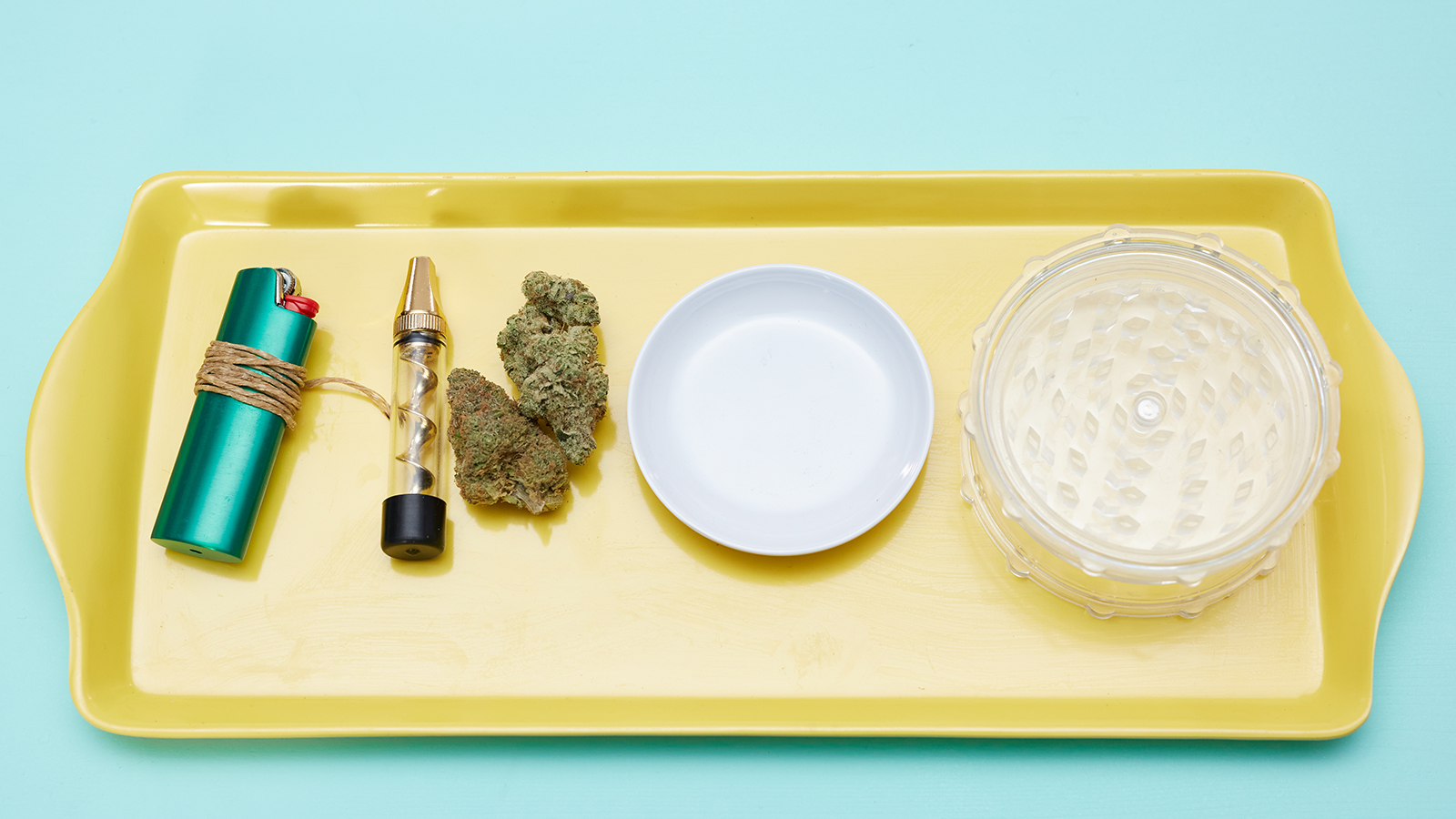Similar to joints with a culture all their own, blunts are a mainstay in the world of cannabis. But unlike joints, which are wrapped with standard rolling papers sometimes made of hemp or other natural fibers, blunts are usually wrapped with tobacco leaves. Learn more about blunts and how to roll one.
Why is it called a blunt?
The term “blunt" originated with an American brand of cigars called Phillies. The Phillies brand manufactured a cigar called a Blunt that's wider than a cigarillo but not as wide as a Corona. It's designed to be smoked more quickly than its full-size counterparts. Because it's machine-made rather than hand-rolled, it's also less expensive. That may have led cannabis lovers to choose it when they looked for a more discreet way of enjoying a smoke.
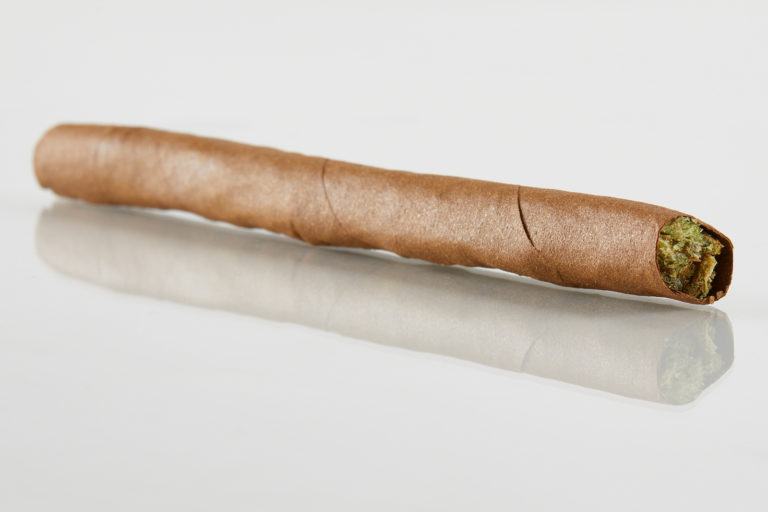 Photo by: Gina Coleman/Weedmaps
Photo by: Gina Coleman/WeedmapsImage lightbox

Not to be confused with a spliff, which is tobacco rolled together with weed or hash inside a joint, blunts first became popular in cities in the Northeast. Over time, the term came to mean what it does in today's cannabis culture: cannabis inside either a hollowed-out cigar or tobacco paper.
What are blunt wraps?
Blunt wraps are another term for tobacco leaf wraps, which provide many distinctive blunt qualities, including taste, smell, effect, and burn time. Selecting the right blunt wrap is at the heart of rolling blunts, as blunt aficionados tend to be loyal to one brand of paper, using it almost exclusively.
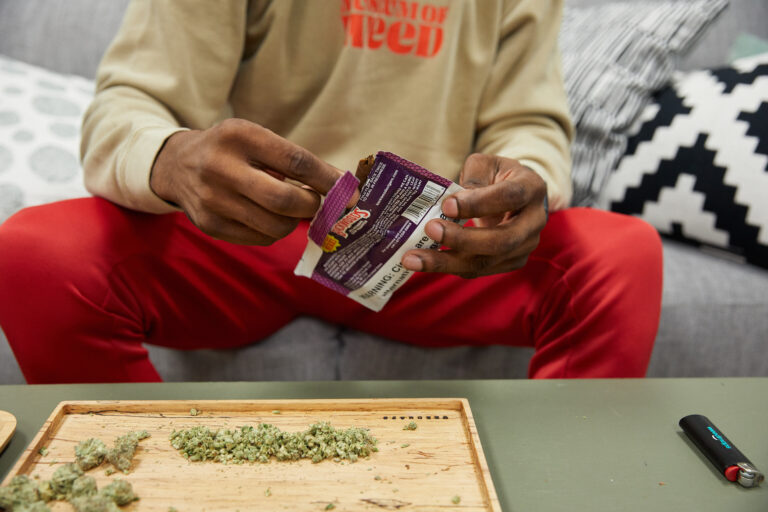 Photo by: Gina Coleman/Weedmaps
Photo by: Gina Coleman/WeedmapsImage lightbox

There are two main ways to procure your tobacco wrapping paper:
- Purchase a pre-rolled cigar or cigarillo, empty out the contents, and then repurpose the tobacco wrapping paper by filling it with weed before re-rolling it into a blunt. Popular cigar and cigarillo brands include Swisher Sweets, Dutch Masters, Backwoods, White Owl, and Phillies.
- Use tobacco leaf paper that comes as-is — usually all-natural, and not a pre-filled cigar or cigarillo. Zig Zag blunt wraps are probably the most common wrap in this category.
Pros and cons of blunts
Depending on your individual preferences and personal health concerns, blunts may or may not be the right choice for you. Consider the pros and cons:
Pros
- Flavor: The tobacco leaf wrapper used in blunts adds a distinct flavor and aroma that some consumers enjoy.
- Slower burn: Blunts generally burn slower than joints, making them last longer — which makes them more suitable for group settings or sharing with others.
- Potency: Blunts can hold more cannabis than joints or other smoking methods, leading to a more potent experience.
- Social aspect: Rolling and sharing a blunt is great for communal bonding with fellow cannabis enthusiasts.
Cons
- Health risks: Combining tobacco and cannabis increases the health risks associated with smoking, including respiratory issues, increased risk of lung cancer, and other tobacco-related health problems.
- Potential for overconsumption: Tobacco is known to be addictive due to its nicotine content, and blunt smokers may develop a dependence on it. Additionally, the fact that blunts hold more cannabis flower than joints may make it easier to over-consume.
- Learning curve: Rolling a blunt can be more complex than rolling a joint — particularly for those new to the practice.
- Odor: A pro for some can be a con for others. Blunts can produce a stronger and more pungent smell than joints or other smoking methods, which might not be desirable in certain situations or environments.
How to roll a blunt: Step-by-step guide
Learning how to roll a perfect blunt takes practice — if you don't succeed at first, keep trying. Intrepid and experienced consumers may even feel inspired to add concentrates or kief.
Supplies
- Cannabis strain of choice
- Grinder
- Rolling tray
- Blunt wrap or cigarillo
- Sharp knife or razor blade
- Lighter
- Hemp wick (optional)
Step 1: Grind weed
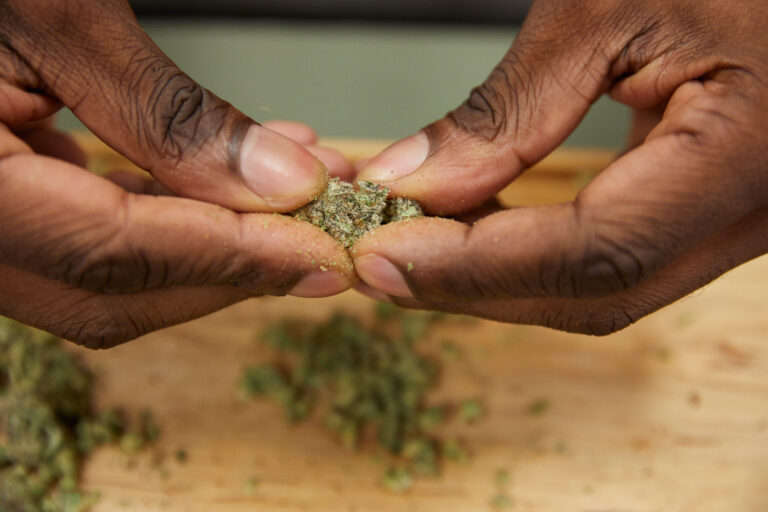 Photo by: Gina Coleman/Weedmaps
Photo by: Gina Coleman/WeedmapsImage lightbox

Grind your weed with a grinder or break it apart with your hands. A grinder will give you the most consistent grind for a smoother, more even burn throughout the blunt session.
Step 2: Break down blunt wrap
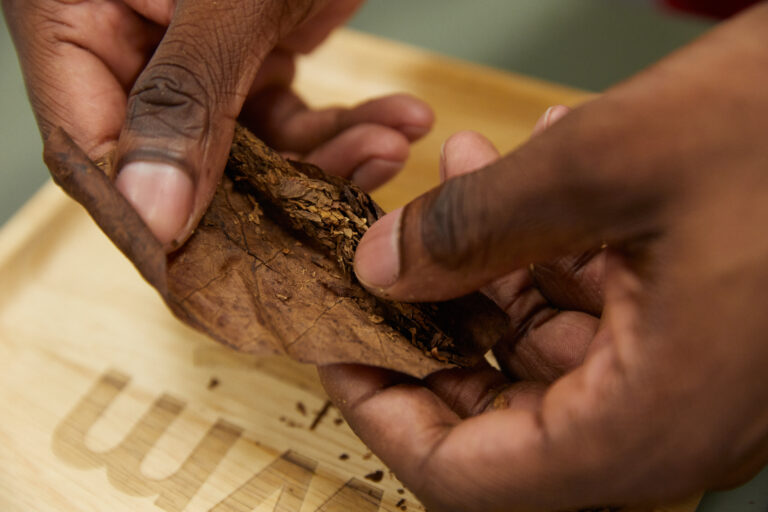 Photo by: Gina Coleman/Weedmaps
Photo by: Gina Coleman/WeedmapsImage lightbox

Break down a cigar or cigarillo wrap with a razor blade, splitting it lengthwise down the middle. You can also use your hands, being careful to break apart the wrapper without tearing it through or cracking it.
Note: If you bought an unfilled tobacco wrap, skip this step.
Step 3: Empty tobacco
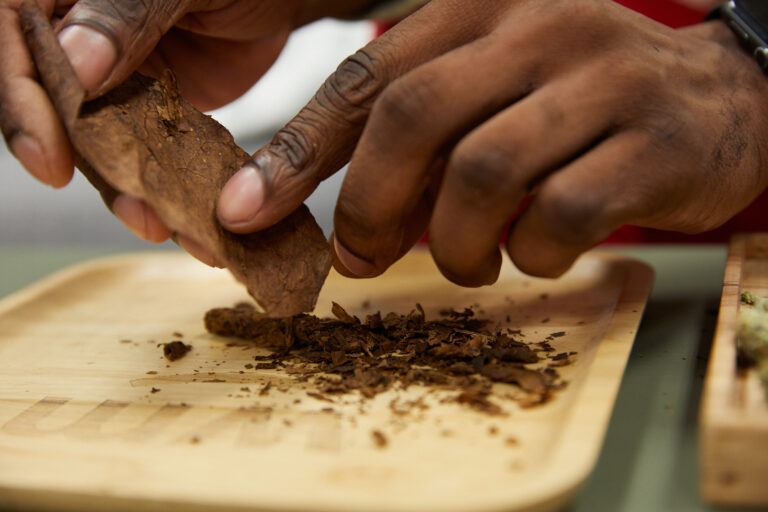 Photo by: Gina Coleman/Weedmaps
Photo by: Gina Coleman/WeedmapsImage lightbox

Once you've opened the cigar or cigarillo, empty out and discard the tobacco within.
Step 4: Moisten wrap
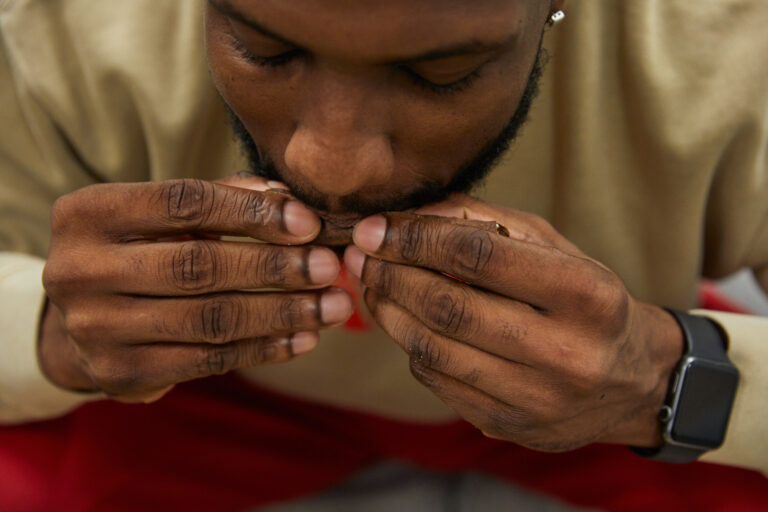 Photo by: Gina Coleman/Weedmaps
Photo by: Gina Coleman/WeedmapsImage lightbox

Get the wrap slightly moist to make the tobacco leaf more pliable and easier to work with. You can use either water or saliva for this, so long as you avoid getting it sopping wet.
Step 5: Place ground weed in wrap
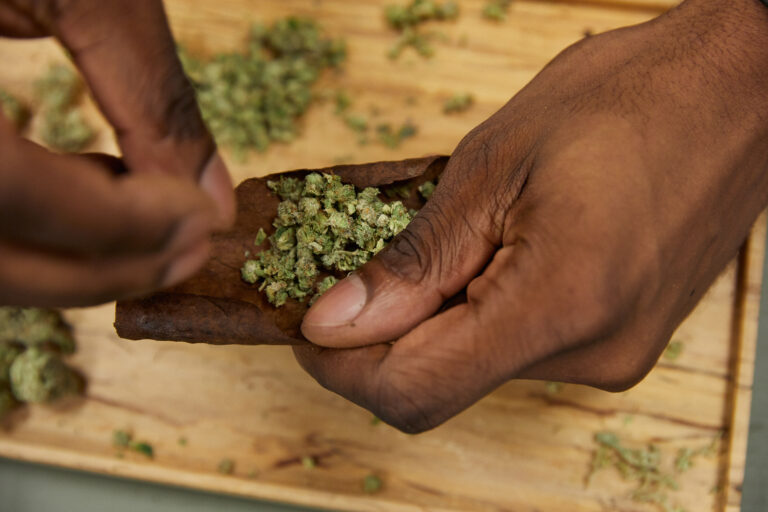 Photo by: Gina Coleman/Weedmaps
Photo by: Gina Coleman/WeedmapsImage lightbox

Hold the tobacco wrap in your non-dominant hand. Position your index fingers and thumbs so that you form the wrap into a U-shaped trough.
Then, grab a pinch of your ground-up cannabis and place it inside the tobacco wrap, forming a line that runs the entire length. Leave enough space to wrap the tobacco leaf into a cylinder that completely encases the cannabis.
Step 6: Roll up
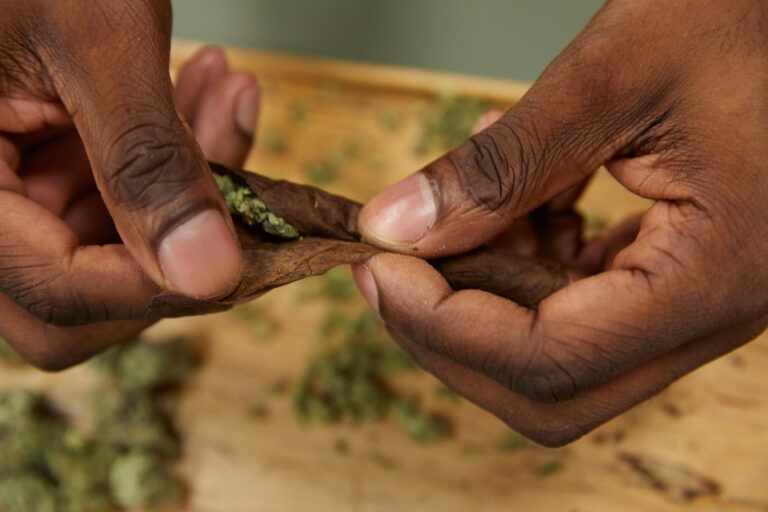 Photo by: Gina Coleman/Weedmaps
Photo by: Gina Coleman/WeedmapsImage lightbox

Gently rock the wrapping paper back and forth, tamping down and evening out the cannabis. This technique will begin to shape your blunt into a cylinder that is uniform in thickness.
When you've got the right shape formed, bring one edge of the wrap over the cannabis and tuck it underneath the opposite side of the wrap. At this point, the wrap should completely encase the cannabis.
Step 7: Seal
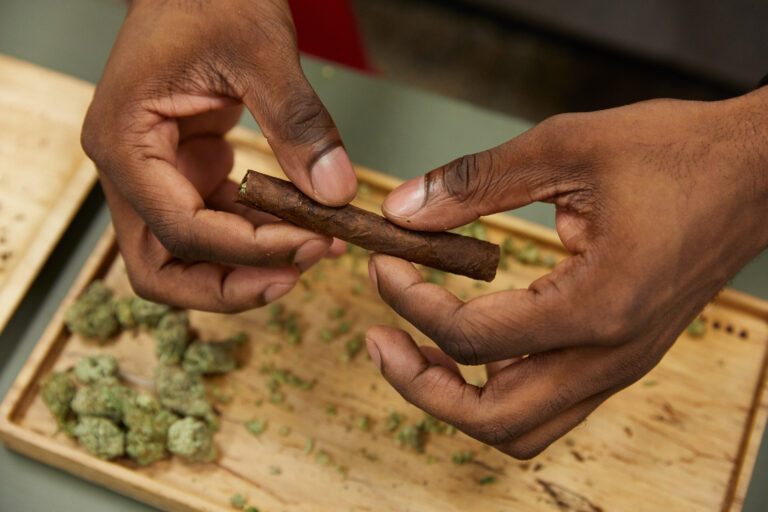 Photo by: Gina Coleman/Weedmaps
Photo by: Gina Coleman/WeedmapsImage lightbox

When the blunt is rolled, moisten the inside edge of the remaining wrapper and press it firmly against the outside of the blunt to create a seal. Run your lighter gently along the seam to help the wrapper stick together and create a smooth surface. This also dries out the tobacco and locks the seam in place, so the blunt doesn't fall apart when you're smoking it.
Step 8: Light up
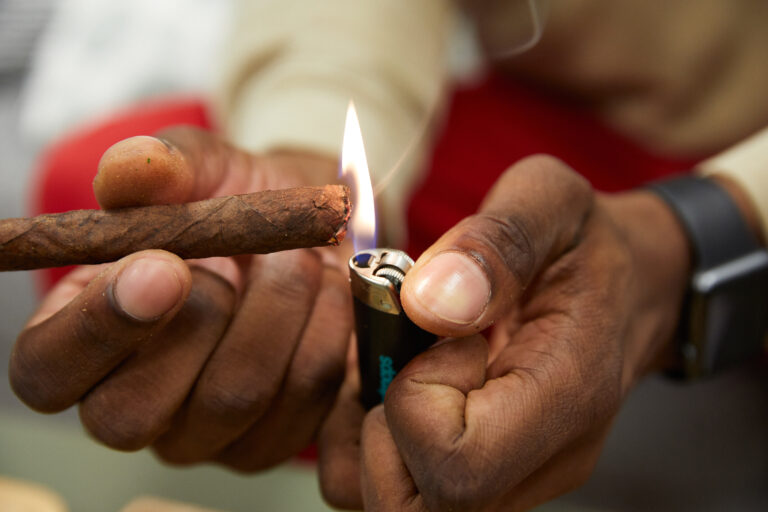 Photo by: Gina Coleman/Weedmaps
Photo by: Gina Coleman/WeedmapsImage lightbox

Light up one end of your blunt using a lighter or a lit hemp wick and inhale from the other end.
Tips for rolling and smoking blunts
Perfect your blunt practice with the following tips:
- Use a grinder for an even burn. If you don't have a grinder, carefully break apart your weed with your fingers or grab some small scissors to cut the bud into small, even pieces. Be as delicate as you can to minimize damage to the cannabinoid-rich trichomes as you go.
- Use a crutch to avoid inhaling burning embers — affectionately called “scooby snacks” — from the blunt.
- Try different blunt wraps. If you're new to blunts, experiment with a handful of brands. You can even test a flavored wrap. Figuring out which blunt wrap you like the best is half the fun.
- Use restraint when moistening the blunt wrap. Some folks lick the blunt wrap, while others use a paintbrush moistened with water. Whatever you do, avoid getting it sopping wet because the entire blunt could disintegrate. Just moisten the wrap enough to make it easier to handle.
- Rotate the blunt as you light it. Rotate the blunt while holding the flame to the end to ensure an even burn. Take a few gentle puffs to help establish an even cherry, which is the burning tip.
- Be gentle when puff-puff-passing. When sharing the blunt with others, pass it gently. Squeezing or damaging the wrapper could cause it to unravel or burn unevenly.
You can also try your hand at rolling a blunt with the help of a sushi mat or use rose petals as a wrap.
FAQ
What is the difference between a blunt and a joint?
A blunt uses a tobacco leaf, cigar, or cigarillo wrapper, while a joint uses rolling papers made from wood pulp, hemp, or rice. Blunts generally hold more cannabis and burn slower than joints.
What is the difference between a blunt and a spliff?
A spliff is made with regular rolling papers with tobacco and weed rolled together. A blunt is a hollowed-out cigar or tobacco paper filled with cannabis.
Are blunts more potent than joints or weed smoked from a pipe?
Blunts can be more potent than joints or cannabis smoked from pipes due to their ability to hold more cannabis. Plus, the tobacco used to produce blunts can create a head rush effect in some consumers, giving them the impression that blunts get you higher. However, the more realistic reason blunts generate a more potent buzz is that they can hold more cannabis than your average pipe or joint.
How much does a blunt cost?
The price of a blunt or blunt wrap varies depending on the brand, the size of the blunt, and the location where it's sold. A recent check of dispensaries in Los Angeles found blunts priced between $17 and $55. You can usually find cigar blunts at a gas station, convenience store, tobacco store, or head shop. Blunt wraps can be found at head shops and dispensaries, including online. The price is usually less than $5 each. Today's cigar blunts are encased in a wrapper made from tobacco scraps and plant fibers pressed into sheets, but it's possible to buy whole tobacco leaves online.
Are blunts safe to smoke?
Smoking poses health risks, and smoking blunts does as well due to the combination of tobacco and cannabis. Risks from long-term use can include respiratory issues, increased risk of lung cancer, and other tobacco-related health problems.
Can blunts be addictive?
Blunts can be addictive, primarily because tobacco contains nicotine, which is an addictive substance.
Are there flavored blunt wraps?
Yes, blunt wraps are available in various flavors, such as grape, cherry, and chocolate. These wraps can add complexity to the taste and scent profiles of the smoking experience.
Is it difficult to roll a blunt?
Rolling a blunt can be more challenging than rolling a joint, particularly for those new to the technique. It requires skill and practice to master.
Can you smoke blunts in public?
Laws regarding smoking blunts in public vary depending on the jurisdiction. It is essential to understand and follow local laws and regulations surrounding cannabis and tobacco use.
How do you store a blunt for later use?
To store a blunt for later use, place it in an airtight container or resealable plastic bag once it is completely cool. Store the container in a cool, dry place away from direct sunlight to keep your blunt fresh and prevent it from drying out.
What's a glass blunt?
A glass blunt is a reusable smoking device made of glass that's designed to mimic the experience of smoking a traditional rolled blunt. It consists of a cylindrical glass tube, often with a mouthpiece on one end and an adjustable, screw-like mechanism or sliding component on the other. This allows you to control the amount of cannabis inside the glass tube and facilitates easy ash removal.
Written by Tony Daniels | Featured image by Gina Coleman/Weedmaps




